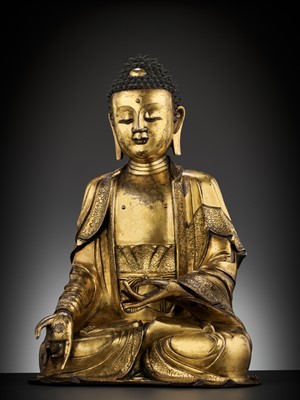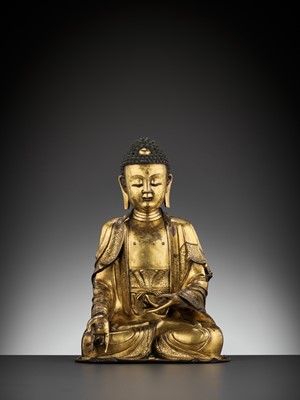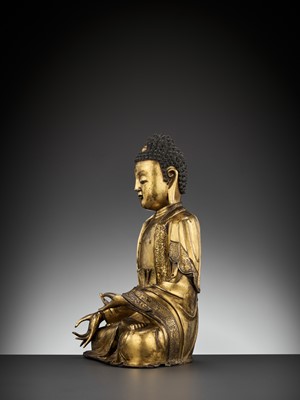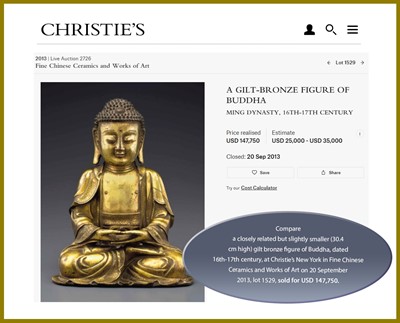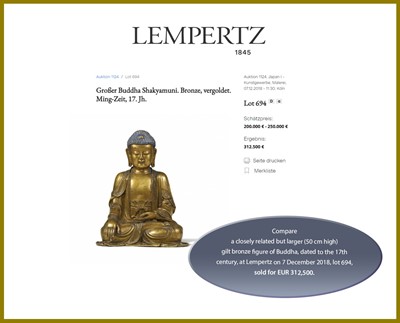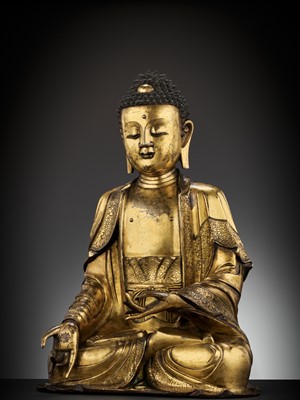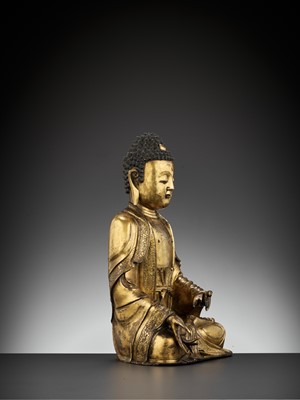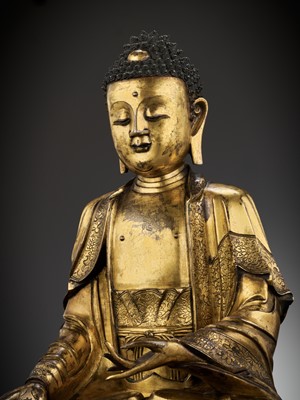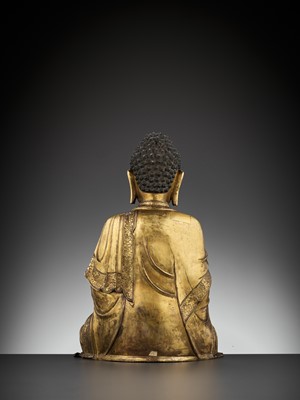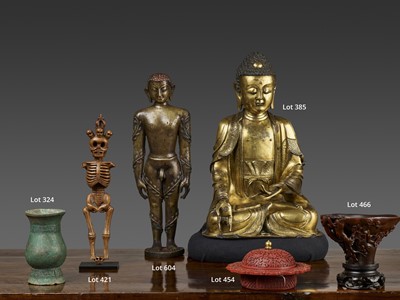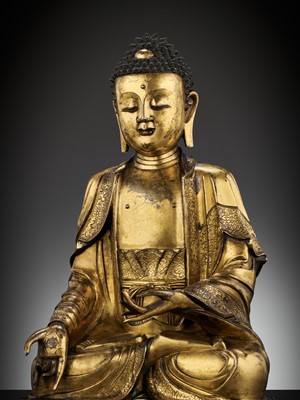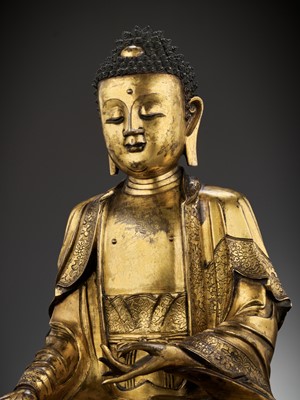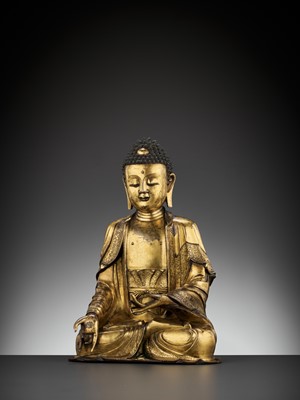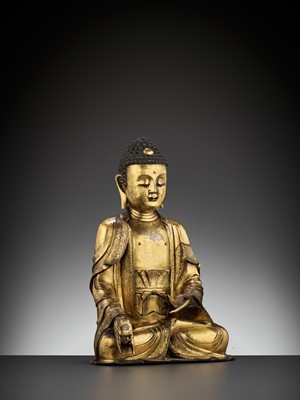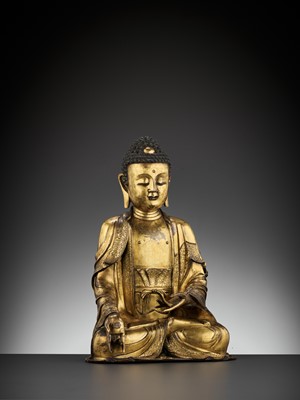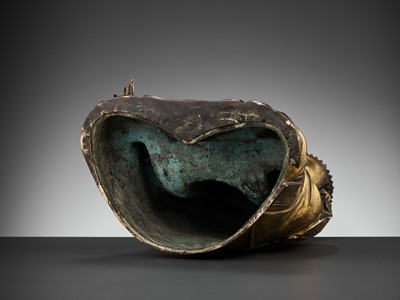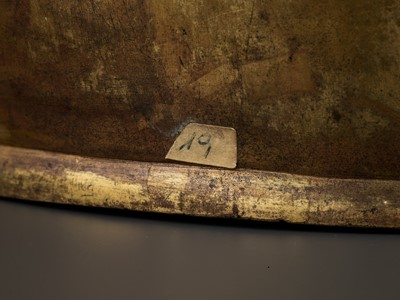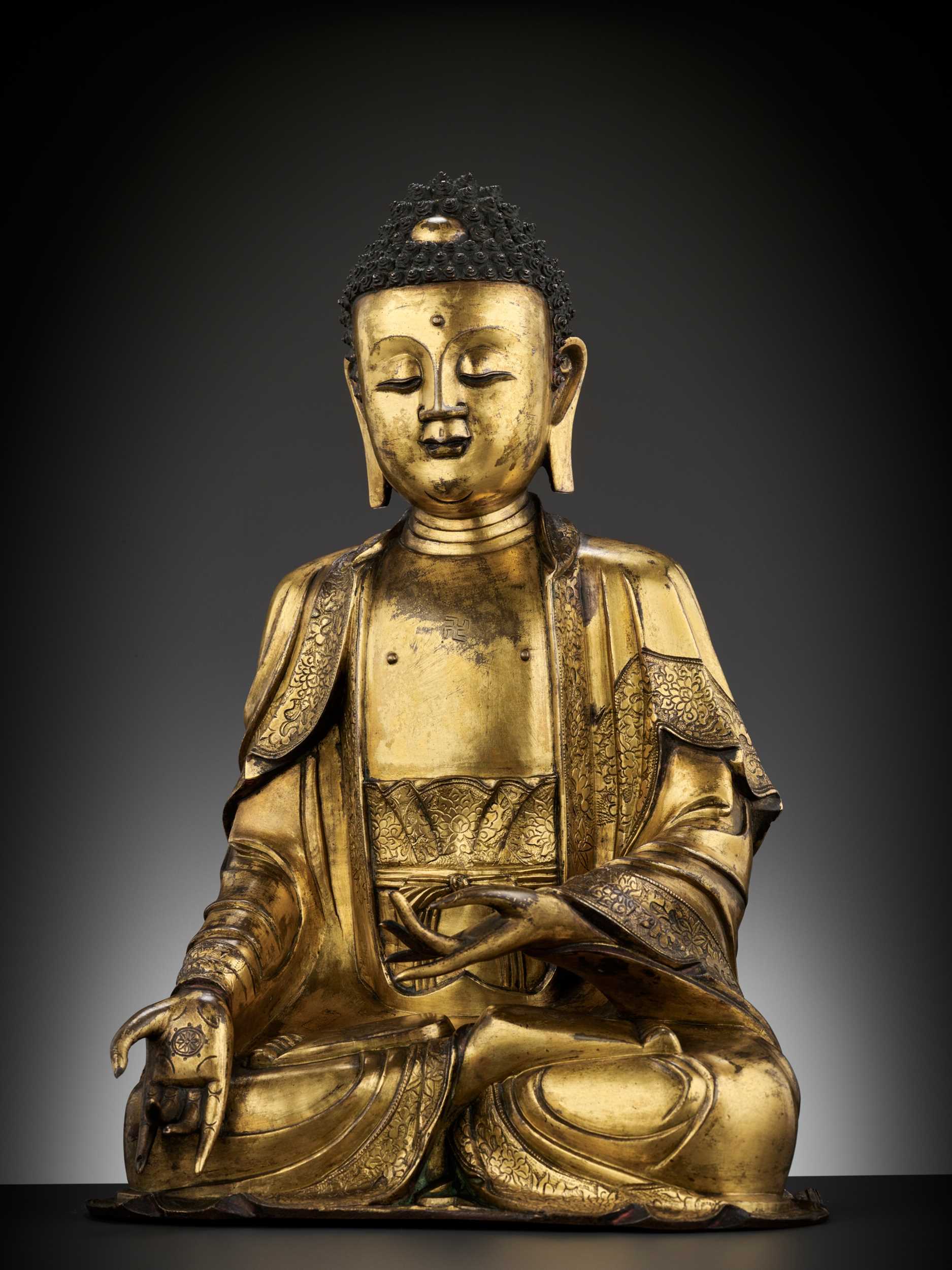16th Oct, 2021 10:00
TWO-DAY AUCTION - Fine Chinese Art / 中國藝術集珍 / Buddhism & Hinduism
385
AN IMPORTANT GILT BRONZE FIGURE OF BUDDHA, MING DYNASTY
明代重要銅鎏金阿彌陀佛像
Sold for €63,200
including Buyer's Premium
China, 1368-1644. Heavily cast seated in dhyanasana with his hands held in varada mudra, wearing loose-fitting monastic robes with finely incised foliate borders falling in graceful folds. The face is well cast in a meditative expression, with heavy-lidded downcast eyes and full lips forming a subtle smile, flanked by large, elongated ears. His wide forehead centered with a small circular urna , the hair arranged in tight curls, and the domed ushnisa fronted with a larger subsidiary urna.
Provenance: From a noted private collector and thence by descent. Old collector’s label ‘19’ to back.
Condition: Very good condition with old wear, particularly to gilt in exposed areas, minor casting flaws, shallow surface scratches, few minuscule nicks, minor losses. Remnants of pigment.
Weight: 7.1 kg
Dimensions: Height 38 cm (excl. base) and 42.5 cm (incl. base)
A wan (swastika) symbol is incised to the Buddha’s chest and dharma wheels are incised to the palms of his hands and soles of his feet.
With an associated, fitted wood base overall coated in red silk, dating from the late 19th to the earlier 20th century. The silk with wear, faded colors and tears. (2)
Expert’s note: The bronze holds several meticulously inlaid and distinct miniature plaques of rectangular shape. These typically have a ritual purpose, and are sometimes found in ancient Buddhist sculptures. Mahayana Buddhism, the predominant form in traditional China, teaches that there are an infinite number of Buddhas, all of whom are deities. The most popular Buddhas, and thus the most frequently portrayed, are Shakyamuni (the Historical Buddha), Amitabha (the Buddha of Infinite Light) and Bhaishajyaguru (the Medicine Buddha). Although Tibetan Buddhist imagery began to appear in the repertory of Chinese art already in the Yuan dynasty (1279-1368), Tibetan influence on Chinese Buddhist art became far more pronounced in the Ming dynasty (1368-1644), particularly during and after the Yongle era (1403-1425), when the imperial court looked favorably upon Buddhism and made a concerted effort to build secular and religious alliances with Tibet, even inviting Tibetan monks to the capital, Beijing, to conduct religious services. In images of bodhisattvas, such Tibetan influence manifests itself in the sensuous presentation of the deity, but in images of the Buddha it is apparent in the relatively square face, the forward-turning ears, the full fleshy cheeks that frame the shallow concave depression that includes the small mouth, which is set in a subtle smile, the refined gestures, and the abundant and meticulously rendered details. All of these stylistic characteristics are visible in the present figure.
Auction result comparison: Compare a closely related but slightly smaller (30.4 cm high) gilt bronze figure of Buddha, dated 16th-17th century, at Christie’s New York in Fine Chinese Ceramics and Works of Art on 20 September 2013, lot 1529, sold for USD 147,750. Compare also a closely related but larger (50 cm high) gilt bronze figure of Buddha, dated to the 17th century, at Lempertz on 7 December 2018, lot 694, sold for EUR 312,500.
明代重要銅鎏金阿彌陀佛像
中國, 1368-1644年。此尊髮髻高束,面龐豐腴,雙目垂俯,眉間有白毫,相容和熙。肩胸寬厚,體態飽滿。身著敞胸袈裟,衣緣鏨刻精美的纏枝花卉,折疊曲复,曲走流回自然。左手結禪定印,右手指地結觸地印,跏趺端坐於仰覆蓮台座。
來源:知名私人收藏,保存至今。背面可見老藏家標籤“19”。
品相:狀況極好,磨損嚴重,尤其是暴露區域的鎏金,輕微鑄造缺陷,表面淺划痕,微小的划痕,輕微缺損,色素殘留。
重量:7.1 公斤
尺寸:高 38 厘米 (不含底座),總42.5 厘米
阿彌陀佛的胸口刻有萬字,手掌和腳底刻有法輪。
配套木質底座,整體覆蓋有紅綢,可追溯至 19 世紀末至 20 世紀初。 絲綢磨損,褪色和水跡。(2)
專家注釋:造像上有鑲嵌的獨特的方形小牌,他們通常具有儀式目的,有時會出現在古代佛教雕塑中。大乘佛教是中國盛行的佛教,最受歡迎也最常出現的是釋迦牟尼、阿彌陀佛和藥師佛。儘管藏傳佛教圖像在元朝(1279-1368 年)就開始出現在中國藝術中,但在明朝(1368-1644 年),尤其是在永樂朝之後,西藏對中國佛教藝術的影響變得更加顯著。公元1403-1425年,朝廷與西藏齊心協力建立宗教聯盟,甚至邀請西藏僧侶到首都北京進行宗教儀式。在佛教造像中,這種藏族的影響體現在造像的面部表情上,相對方形的臉、前傾的耳朵、豐滿的臉頰,包括含蓄的微笑、精緻的手印,所有這些風格特徵都在本圖中可見。
拍賣結果比較:比較一件相近但稍小 (高30.4 厘米) 的鎏金銅佛陀造像,十六至十七世紀,見紐約佳士得Fine Chinese Ceramics and Works of Art 2013年9月20日 lot 1529, 售價USD 147,750;一件稍大 (高50 厘米)鎏金銅佛 ,十七世紀,見Lempertz 2018年12月7日 lot 694, 售價EUR 312,500。
China, 1368-1644. Heavily cast seated in dhyanasana with his hands held in varada mudra, wearing loose-fitting monastic robes with finely incised foliate borders falling in graceful folds. The face is well cast in a meditative expression, with heavy-lidded downcast eyes and full lips forming a subtle smile, flanked by large, elongated ears. His wide forehead centered with a small circular urna , the hair arranged in tight curls, and the domed ushnisa fronted with a larger subsidiary urna.
Provenance: From a noted private collector and thence by descent. Old collector’s label ‘19’ to back.
Condition: Very good condition with old wear, particularly to gilt in exposed areas, minor casting flaws, shallow surface scratches, few minuscule nicks, minor losses. Remnants of pigment.
Weight: 7.1 kg
Dimensions: Height 38 cm (excl. base) and 42.5 cm (incl. base)
A wan (swastika) symbol is incised to the Buddha’s chest and dharma wheels are incised to the palms of his hands and soles of his feet.
With an associated, fitted wood base overall coated in red silk, dating from the late 19th to the earlier 20th century. The silk with wear, faded colors and tears. (2)
Expert’s note: The bronze holds several meticulously inlaid and distinct miniature plaques of rectangular shape. These typically have a ritual purpose, and are sometimes found in ancient Buddhist sculptures. Mahayana Buddhism, the predominant form in traditional China, teaches that there are an infinite number of Buddhas, all of whom are deities. The most popular Buddhas, and thus the most frequently portrayed, are Shakyamuni (the Historical Buddha), Amitabha (the Buddha of Infinite Light) and Bhaishajyaguru (the Medicine Buddha). Although Tibetan Buddhist imagery began to appear in the repertory of Chinese art already in the Yuan dynasty (1279-1368), Tibetan influence on Chinese Buddhist art became far more pronounced in the Ming dynasty (1368-1644), particularly during and after the Yongle era (1403-1425), when the imperial court looked favorably upon Buddhism and made a concerted effort to build secular and religious alliances with Tibet, even inviting Tibetan monks to the capital, Beijing, to conduct religious services. In images of bodhisattvas, such Tibetan influence manifests itself in the sensuous presentation of the deity, but in images of the Buddha it is apparent in the relatively square face, the forward-turning ears, the full fleshy cheeks that frame the shallow concave depression that includes the small mouth, which is set in a subtle smile, the refined gestures, and the abundant and meticulously rendered details. All of these stylistic characteristics are visible in the present figure.
Auction result comparison: Compare a closely related but slightly smaller (30.4 cm high) gilt bronze figure of Buddha, dated 16th-17th century, at Christie’s New York in Fine Chinese Ceramics and Works of Art on 20 September 2013, lot 1529, sold for USD 147,750. Compare also a closely related but larger (50 cm high) gilt bronze figure of Buddha, dated to the 17th century, at Lempertz on 7 December 2018, lot 694, sold for EUR 312,500.
明代重要銅鎏金阿彌陀佛像
中國, 1368-1644年。此尊髮髻高束,面龐豐腴,雙目垂俯,眉間有白毫,相容和熙。肩胸寬厚,體態飽滿。身著敞胸袈裟,衣緣鏨刻精美的纏枝花卉,折疊曲复,曲走流回自然。左手結禪定印,右手指地結觸地印,跏趺端坐於仰覆蓮台座。
來源:知名私人收藏,保存至今。背面可見老藏家標籤“19”。
品相:狀況極好,磨損嚴重,尤其是暴露區域的鎏金,輕微鑄造缺陷,表面淺划痕,微小的划痕,輕微缺損,色素殘留。
重量:7.1 公斤
尺寸:高 38 厘米 (不含底座),總42.5 厘米
阿彌陀佛的胸口刻有萬字,手掌和腳底刻有法輪。
配套木質底座,整體覆蓋有紅綢,可追溯至 19 世紀末至 20 世紀初。 絲綢磨損,褪色和水跡。(2)
專家注釋:造像上有鑲嵌的獨特的方形小牌,他們通常具有儀式目的,有時會出現在古代佛教雕塑中。大乘佛教是中國盛行的佛教,最受歡迎也最常出現的是釋迦牟尼、阿彌陀佛和藥師佛。儘管藏傳佛教圖像在元朝(1279-1368 年)就開始出現在中國藝術中,但在明朝(1368-1644 年),尤其是在永樂朝之後,西藏對中國佛教藝術的影響變得更加顯著。公元1403-1425年,朝廷與西藏齊心協力建立宗教聯盟,甚至邀請西藏僧侶到首都北京進行宗教儀式。在佛教造像中,這種藏族的影響體現在造像的面部表情上,相對方形的臉、前傾的耳朵、豐滿的臉頰,包括含蓄的微笑、精緻的手印,所有這些風格特徵都在本圖中可見。
拍賣結果比較:比較一件相近但稍小 (高30.4 厘米) 的鎏金銅佛陀造像,十六至十七世紀,見紐約佳士得Fine Chinese Ceramics and Works of Art 2013年9月20日 lot 1529, 售價USD 147,750;一件稍大 (高50 厘米)鎏金銅佛 ,十七世紀,見Lempertz 2018年12月7日 lot 694, 售價EUR 312,500。
Zacke Live Online Bidding
Our online bidding platform makes it easier than ever to bid in our auctions! When you bid through our website, you can take advantage of our premium buyer's terms without incurring any additional online bidding surcharges.
To bid live online, you'll need to create an online account. Once your account is created and your identity is verified, you can register to bid in an auction up to 12 hours before the auction begins.
Intended Spend and Bid Limits
When you register to bid in an online auction, you will need to share your intended maximum spending budget for the auction. We will then review your intended spend and set a bid limit for you. Once you have pre-registered for a live online auction, you can see your intended spend and bid limit by going to 'Account Settings' and clicking on 'Live Bidding Registrations'.
Your bid limit will be the maximum amount you can bid during the auction. Your bid limit is for the hammer price and is not affected by the buyer’s premium and VAT. For example, if you have a bid limit of €1,000 and place two winning bids for €300 and €200, then you will only be able to bid €500 for the rest of the auction. If you try to place a bid that is higher than €500, you will not be able to do so.
Online Absentee and Telephone Bids
You can now leave absentee and telephone bids on our website!
Absentee Bidding
Once you've created an account and your identity is verified, you can leave your absentee bid directly on the lot page. We will contact you when your bids have been confirmed.
Telephone Bidding
Once you've created an account and your identity is verified, you can leave telephone bids online. We will contact you when your bids have been confirmed.
Classic Absentee and Telephone Bidding Form
You can still submit absentee and telephone bids by email or fax if you prefer. Simply fill out the Absentee Bidding/Telephone bidding form and return it to us by email at office@zacke.at or by fax at +43 (1) 532 04 52 20. You can download the PDF from our Upcoming Auctions page.
How-To Guides
How to Create Your Personal Zacke Account
How to Register to Bid on Zacke Live
How to Leave Absentee Bids Online
How to Leave Telephone Bids Online
中文版本的操作指南
创建新账号
注册Zacke Live在线直播竞拍(免平台费)
缺席投标和电话投标
Third-Party Bidding
We partner with best-in-class third-party partners to make it easy for you to bid online in the channel of your choice. Please note that if you bid with one of our third-party online partners, then there will be a live bidding surcharge on top of your final purchase price. You can find all of our fees here. Here's a full list of our third-party partners:
- 51 Bid Live
- EpaiLive
- ArtFoxLive
- Invaluable
- LiveAuctioneers
- the-saleroom
- lot-tissimo
- Drouot
Please note that we place different auctions on different platforms. For example, in general, we only place Chinese art auctions on 51 Bid Live.
Bidding in Person
You must register to bid in person and will be assigned a paddle at the auction. Please contact us at office@zacke.at or +43 (1) 532 04 52 for the latest local health and safety guidelines.
